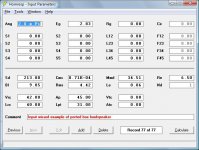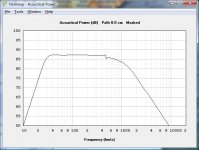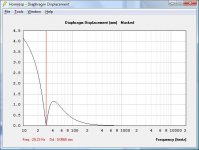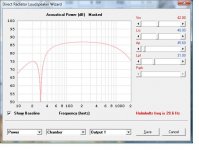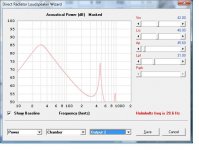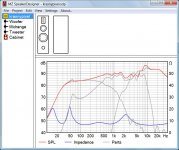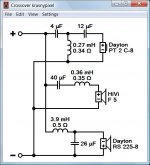Hi guys,
Im new to this forum so apologies for asking maybe mundane question.
I have decided to build my second DIY audio project, 3 way ported loudspeaker.
Components selected for the build were
Lows - Dayton Audio RS225-8 8" Reference Woofer
Mids - HiVi F5 5" Bass/Midrange
Highs - Dayton Audio PT2C-8 Planar Tweeter
Im crossing the drivers using Eminence PXB3:3K5 crossover at 500/3500 hz with 2nd order slope for woofer, 1st order filter for midrange and 3rd order for tweeter
Box and port were calculated in WinISD software. Port is tuned for 30hz in 42 litres enclosure (7.5 cm (3in) diameter, cca 31c (12in) length - flared)
Midrange enclosure is separated from woofer, for the sake of the prototype building however, larger than suggested cabinet size was used (14 litres instead of 5 litres) and was properly damped.
After building prototype enclosure for the speaker and testing the speaker i was
a) Amazed by performance in mid and high range, clarity and separation of instruments is very nice, especially considering that the prototype build is rough.
b) Weak low-range performance. Bass is clear , however it lacks any depth and "punchiness" . Im not talking about groundshaking performance, but overall, the bass is weak.
This was confirmed by measurement which has shown 6-7db lower performance across the band, up to the 500hz crossover frequency.
When I adjusted preamplifier to +7db for lows and -7db for highs, sound started to appear more balanced, but I still was a little bit disappointed by the overall performance.
I was rather surprised by this issue, as this is my second build (first was 2way speaker) , and It was calculated the same way. First build has amazing bass considering that it uses only 4inch midwoofer drivers.
Could you please advise me what could I do wrong? Many thanks for your replies.
Im new to this forum so apologies for asking maybe mundane question.
I have decided to build my second DIY audio project, 3 way ported loudspeaker.
Components selected for the build were
Lows - Dayton Audio RS225-8 8" Reference Woofer
Mids - HiVi F5 5" Bass/Midrange
Highs - Dayton Audio PT2C-8 Planar Tweeter
Im crossing the drivers using Eminence PXB3:3K5 crossover at 500/3500 hz with 2nd order slope for woofer, 1st order filter for midrange and 3rd order for tweeter
Box and port were calculated in WinISD software. Port is tuned for 30hz in 42 litres enclosure (7.5 cm (3in) diameter, cca 31c (12in) length - flared)
Midrange enclosure is separated from woofer, for the sake of the prototype building however, larger than suggested cabinet size was used (14 litres instead of 5 litres) and was properly damped.
After building prototype enclosure for the speaker and testing the speaker i was
a) Amazed by performance in mid and high range, clarity and separation of instruments is very nice, especially considering that the prototype build is rough.
b) Weak low-range performance. Bass is clear , however it lacks any depth and "punchiness" . Im not talking about groundshaking performance, but overall, the bass is weak.
This was confirmed by measurement which has shown 6-7db lower performance across the band, up to the 500hz crossover frequency.
When I adjusted preamplifier to +7db for lows and -7db for highs, sound started to appear more balanced, but I still was a little bit disappointed by the overall performance.
I was rather surprised by this issue, as this is my second build (first was 2way speaker) , and It was calculated the same way. First build has amazing bass considering that it uses only 4inch midwoofer drivers.
Could you please advise me what could I do wrong? Many thanks for your replies.
By saying that you compensated for a measured result, I assume you have dealt with the primary effect of sound at lower frequencies radiating around the enclosure and spreading, rather than going forward.
There is a secondary effect of this, in that this rearward sound reflects off the walls behind and to the side and interferes with the direct sound. It is frequency dependent and is not simple to fix. Try rearranging your speaker location.
Then there are room issues at the lowest frequencies that will probably need attention. You might find interest in the multiple subs thread.
You can also try tilting your response downward at the high end. I can only guess at this one without more information but it is easy enough to try.
There is a secondary effect of this, in that this rearward sound reflects off the walls behind and to the side and interferes with the direct sound. It is frequency dependent and is not simple to fix. Try rearranging your speaker location.
Then there are room issues at the lowest frequencies that will probably need attention. You might find interest in the multiple subs thread.
You can also try tilting your response downward at the high end. I can only guess at this one without more information but it is easy enough to try.
Are you certain the box is not leaking? Is everything nice and tight? Every single small crack sealed? Every wire coupled correctly? No phase cancellations? Bad room interaction (some rooms suck the life out of bass)?
May be better to go with something like Dayton Audio DS315-8 with that mid and tweet.
But -7db and+7db so 14db correction? Something is not right.
May be better to go with something like Dayton Audio DS315-8 with that mid and tweet.
But -7db and+7db so 14db correction? Something is not right.
Last edited:
Thank you both for replies,
I have tried switching polarity of drivers and actually achieved better performance with inverted polarity of the woofer (+/-2 db).
Woofer enclosure was glued together, however being perfectly honest, I did not check extremely thoroughly for possible small leaks as I thought that in the vented cabinet with such large vent, these would not have major impact on the bass reflex performance.
I have tried switching polarity of drivers and actually achieved better performance with inverted polarity of the woofer (+/-2 db).
Woofer enclosure was glued together, however being perfectly honest, I did not check extremely thoroughly for possible small leaks as I thought that in the vented cabinet with such large vent, these would not have major impact on the bass reflex performance.
Woofer and mid sensitivity is about the same, tweeter is way more efficient. Tweeter would need attenuation to match the mid properly (by a lot.... 86-87 vs 94dB).
No mention of baffle step correction. Lows tend to flow around the enclosure instead of projecting forwards off the baffle. "The edge" software can model how this might manifest.
Placement of speakers in room is critical if rear ported. I have one in a corner and one near a door. All the bass in room comes from the corner one. The bass for the other tend to appear in the hallway.
HTH
J.
No mention of baffle step correction. Lows tend to flow around the enclosure instead of projecting forwards off the baffle. "The edge" software can model how this might manifest.
Placement of speakers in room is critical if rear ported. I have one in a corner and one near a door. All the bass in room comes from the corner one. The bass for the other tend to appear in the hallway.
HTH
J.
This is a good example of how a premade crossover rarely works good.
Yes, that's the problem.
Components selected for the build were
Lows - Dayton Audio RS225-8 8" Reference Woofer
Mids - HiVi F5 5" Bass/Midrange
Highs - Dayton Audio PT2C-8 Planar Tweeter
Eminence PXB3:3K5 crossover at 500/3500 hz
Box and port : 42 litres enclosure (7.5 cm (3in) diameter, cca 31c (12in) length - flared)
Midrange enclosure is separated from woofer, for the sake of the prototype building however, larger than suggested cabinet size was used (14 litres instead of 5 litres) and was properly damped.
Is the woofer's space (volume) seperated from both the midrange and tweeter? You could be leaking through those other drivers.
a) Amazed by performance in mid and high range, clarity and separation of instruments is very nice, especially considering that the prototype build is rough.
b) Weak low-range performance. Bass is clear , however it lacks any depth and "punchiness" . Im not talking about groundshaking performance, but overall, the bass is weak.
This was confirmed by measurement which has shown 6-7db lower performance across the band, up to the 500hz crossover frequency.
Could you please advise me what could I do wrong? Many thanks for your replies.
The XO points are probably fine but, as you say the FR balance is off. The tweeter you are using has sensitivity of 94db and the woofer/mid is only 85db. That's a 9db difference that will make the speaker sound "bright" (by design) due to the relative differences. Installing an L-pad on the tweeter will fix this.
Second issue is the lack of bass. This might be from baffle step loss or it could be a mistuning, or even a leak. Are you able to post near field measurements for the woofer and its port ?
A quick run on HornResp to check your design tuning (pic#1 and graph#1) and it looks fine. However it does not include bafflestep effects.
To check your LF tuning / construction use a s/w freq generator (like in REW) to look at the woofer movement (graph#3) at the box tuning freq (30Hz) the woofer will barely move. It's a very rough indicator of leaks and construction issues. Measurements are much, much better if you can provide it. I should add that a 12" port tube makes your box deep, or possibly limiting the space behind the tube to operate properly.
To check your LF tuning / construction use a s/w freq generator (like in REW) to look at the woofer movement (graph#3) at the box tuning freq (30Hz) the woofer will barely move. It's a very rough indicator of leaks and construction issues. Measurements are much, much better if you can provide it. I should add that a 12" port tube makes your box deep, or possibly limiting the space behind the tube to operate properly.
Attachments
Last edited:
Is the woofer's space (volume) seperated from both the midrange and tweeter? You could be leaking through those other drivers.
The XO points are probably fine but, as you say the FR balance is off. The tweeter you are using has sensitivity of 94db and the woofer/mid is only 85db. That's a 9db difference that will make the speaker sound "bright" (by design) due to the relative differences. Installing an L-pad on the tweeter will fix this.
Second issue is the lack of bass. This might be from baffle step loss or it could be a mistuning, or even a leak. Are you able to post near field measurements for the woofer and its port ?
Thanks for the answer. Yes, I thought that the tweeter may sound too bright, which (subjectively from listening point is not too big issue in this case.
I will try to check for possible air leaks from the cabinet and make near field measurements of the woofer and the vent
Im attaching links to the cabinet picture
https://1drv.ms/u/s!Ao7eEJyYPDPNg8scp3KdwwfvNKhFWA
https://1drv.ms/u/s!Ao7eEJyYPDPNg8sd2SMDLTD7JMMebA
Are those photos of your prototype ? It's hard to tell how the baffle is held on or what the internal structure of the box is like.
The midrange requires its own separate enclosure (volume) within the speaker box otherwise it will act like a passive radiator and effect the woofers LF performance.
P.S. If you use the advanced "manage attachments" you can insert the photos right into thread. Links always end up breaking over time.
The midrange requires its own separate enclosure (volume) within the speaker box otherwise it will act like a passive radiator and effect the woofers LF performance.
P.S. If you use the advanced "manage attachments" you can insert the photos right into thread. Links always end up breaking over time.
Hi guys,
Im new to this forum so apologies for asking maybe mundane question.
I have decided to build my second DIY audio project, 3 way ported loudspeaker.
Components selected for the build were
Lows - Dayton Audio RS225-8 8" Reference Woofer
Mids - HiVi F5 5" Bass/Midrange
Highs - Dayton Audio PT2C-8 Planar Tweeter
Im crossing the drivers using Eminence PXB3:3K5 crossover at 500/3500 hz with 2nd order slope for woofer, 1st order filter for midrange and 3rd order for tweeter
Box and port were calculated in WinISD software. Port is tuned for 30hz in 42 litres enclosure (7.5 cm (3in) diameter, cca 31c (12in) length - flared)
Midrange enclosure is separated from woofer, for the sake of the prototype building however, larger than suggested cabinet size was used (14 litres instead of 5 litres) and was properly damped.
After building prototype enclosure for the speaker and testing the speaker i was
a) Amazed by performance in mid and high range, clarity and separation of instruments is very nice, especially considering that the prototype build is rough.
b) Weak low-range performance. Bass is clear , however it lacks any depth and "punchiness" . Im not talking about groundshaking performance, but overall, the bass is weak.
This was confirmed by measurement which has shown 6-7db lower performance across the band, up to the 500hz crossover frequency.
When I adjusted preamplifier to +7db for lows and -7db for highs, sound started to appear more balanced, but I still was a little bit disappointed by the overall performance.
I was rather surprised by this issue, as this is my second build (first was 2way speaker) , and It was calculated the same way. First build has amazing bass considering that it uses only 4inch midwoofer drivers.
Could you please advise me what could I do wrong? Many thanks for your replies.
No problem, just insert simple L-pads for mid and tweeter.
Are those photos of your prototype ? It's hard to tell how the baffle is held on or what the internal structure of the box is like.
The midrange requires its own separate enclosure (volume) within the speaker box otherwise it will act like a passive radiator and effect the woofers LF performance.
P.S. If you use the advanced "manage attachments" you can insert the photos right into thread. Links always end up breaking over time.
Hi. Thanks for your response. Yes those are photos of the prototype loudspeaker. I have double checked the cabinet and re-sealed cable holes and some tiny leaks. Afterwards, I have re-tested the speaker and I must conclude that situation is much better
I have measured response of the drivers and following are the results.
Response of the speaker port (20-200hz) measured from 10cm
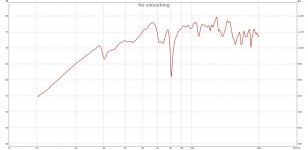
Response of the speaker woofer (20-200hz) measured from 10cm
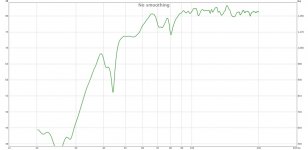
Combined system response (20-10,000hz) measured from 1 meter. With 6db reduction of trebles on preamplifier in order to simulate performance of installed L-pads
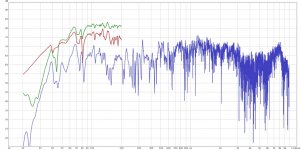
I am much happier with the performance, however I think something is still not 100% OK. Probably it is the port. Although WinISD suggest 30cm depth, it is installed 30cm with one flared end. Effective length is thus probably slightly lower.
I have noticed that the subjective bass intensity was much higher on the sides of the speaker than in front of it. When I was in the hallway 4 meters left to the speaker (which was perpendicularly positioned to me) I have felt ground trembling under my feet. Could this be because of front positioned port?
Many thanks for your replies

It should not matter if the port is in the front. It does look like the tuning is higher than predicted. In your graph#2 the dip is around 45Hz and it should be around 30Hz (see graph below). I've attached a HornResp sim for the driver output. You will get a better graph of just the driver if you measure closer (4cm).
The box tuning may be higher due to a smaller volume (its <42L) or the midrange is not entirely separated and is acting like a passive radiator, or the port tube is restricted. How much distance from the rear tube to the rear cabinet wall?
If you measure with the box against the wall or on the floor you will get more bass. It's better to have it on a stand, away from a wall (1m) for more accurate measurements. You may also want to apply an IR window (-20,40ms) and smoothing (1/12 octave) to your graph to make it less noisy,.. everyone has their favourite settings.
The box tuning may be higher due to a smaller volume (its <42L) or the midrange is not entirely separated and is acting like a passive radiator, or the port tube is restricted. How much distance from the rear tube to the rear cabinet wall?
If you measure with the box against the wall or on the floor you will get more bass. It's better to have it on a stand, away from a wall (1m) for more accurate measurements. You may also want to apply an IR window (-20,40ms) and smoothing (1/12 octave) to your graph to make it less noisy,.. everyone has their favourite settings.
Attachments
It should not matter if the port is in the front. It does look like the tuning is higher than predicted. In your graph#2 the dip is around 45Hz and it should be around 30Hz (see graph below). I've attached a HornResp sim for the driver output. You will get a better graph of just the driver if you measure closer (4cm).
The box tuning may be higher due to a smaller volume (its <42L) or the midrange is not entirely separated and is acting like a passive radiator, or the port tube is restricted. How much distance from the rear tube to the rear cabinet wall?
If you measure with the box against the wall or on the floor you will get more bass. It's better to have it on a stand, away from a wall (1m) for more accurate measurements. You may also want to apply an IR window (-20,40ms) and smoothing (1/12 octave) to your graph to make it less noisy,.. everyone has their favourite settings.
Thanks for advice,
Box itself is 42,8l, however port itself as well as woofer should account for 1-2 litres volume substraction. I have made new measurements with speaker standing on 50cm stand and cca 80cm from the wall.
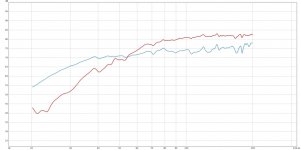
Blue is the response of the port and red is response of the woofer. As you can see. SPL is -10db in the range 35-55 db.
That does not look right. You should see a port peak at 30hz and a driver dip at 30Hz. It looks like the box is leaking. I added the port output below, and the driver output was in previous post.
Try to open the IR window (left 50, right 100) and enable FDW=6. The window may be too small.
Try to open the IR window (left 50, right 100) and enable FDW=6. The window may be too small.
Attachments
Last edited:
Hi,
I wouldn't worry about the bass as long as mid and tweeter levels are too high.
Attached is a simulation of your current setup. Due to baffle step the woofer only reaches a sensitivity of 84 dB.
Beside the level issue, I also think that the first order crossover in the midrange section doesn't work satisfactorily.
I wouldn't worry about the bass as long as mid and tweeter levels are too high.
Attached is a simulation of your current setup. Due to baffle step the woofer only reaches a sensitivity of 84 dB.
Beside the level issue, I also think that the first order crossover in the midrange section doesn't work satisfactorily.
Attachments
Thank you both for replies.
I am pretty sure that the box is now properly sealed. If there are any leaks, these should be really tiny.
The space behind the back of the port tube is approx. 5-6cm, port with diameter 7.5 cm should then work properly (i guess).
Thanks for suggestions DonVK. I will remeasure the performance tomorrow. Its 21pm here already and I dont want to disturb neighbours
Dissi, final speaker build should of course have flushed drivers and faceted front baffle. Do you think it will anyhow improve the low bass response?
Thanks
I am pretty sure that the box is now properly sealed. If there are any leaks, these should be really tiny.
The space behind the back of the port tube is approx. 5-6cm, port with diameter 7.5 cm should then work properly (i guess).
Thanks for suggestions DonVK. I will remeasure the performance tomorrow. Its 21pm here already and I dont want to disturb neighbours
Dissi, final speaker build should of course have flushed drivers and faceted front baffle. Do you think it will anyhow improve the low bass response?
Thanks
If you want to measure port and woofer bass output, you should place the mic very near, some half cm from the membrane. Only in this case you won't catch the unwanted box reflections effect.
If your box works as intended your measured curves should look like here (green and blue curves on the fig 4): Monitor Audio Silver 300 loudspeaker Measurements | Stereophile.com
Ralf
If your box works as intended your measured curves should look like here (green and blue curves on the fig 4): Monitor Audio Silver 300 loudspeaker Measurements | Stereophile.com
I'm not sure that 5 cm is enough as a clearance.The space behind the back of the port tube is approx. 5-6cm, port with diameter 7.5 cm should then work properly (i guess).
Not flush drivers is a problem only for tweeters. I'm not sure what you mean for faceted front baffle, but if it something like here SP44 this won't affect the bass performance at all, it will only change the diffraction profile, and can provide benefits for that.Dissi, final speaker build should of course have flushed drivers and faceted front baffle. Do you think it will anyhow improve the low bass response?
Ralf
That does not look right. You should see a port peak at 30hz and a driver dip at 30Hz. It looks like the box is leaking. I added the port output below, and the driver output was in previous post.
Try to open the IR window (left 50, right 100) and enable FDW=6. The window may be too small.
Hi,
It took me a while but I have adjusted the speaker port, added knee bend and made it slightly longer.
After subjective hearing test , one must note that the bass situation has improved. When i added +4-5 db on my preamp, it has started to sound just right.
Measurement confirmed that the speaker port is now performing as it should have, started fully kicking in at 30hz frequency.
What is however still puzzling me, is why the system response without adding 4-5 db on pre-amp so weak untill approx 60db.
Attached are measurements of the port (2cm distance) and system measurement with and without 4-5db adjustment on pre-amp (1m distance) in room conditions.
Can anyone please adwise where could be some hidden error? I was guessing whether this could be caused by slightly lower port diameter (approx 2-3mm) compared to original port, or by adding a knee on the port.
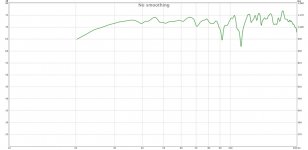
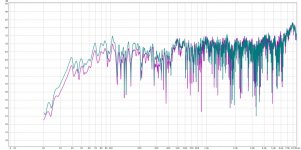
Many thanks in advance

- Status
- This old topic is closed. If you want to reopen this topic, contact a moderator using the "Report Post" button.
- Home
- Loudspeakers
- Multi-Way
- Weaker low-range response of 3-way speaker
